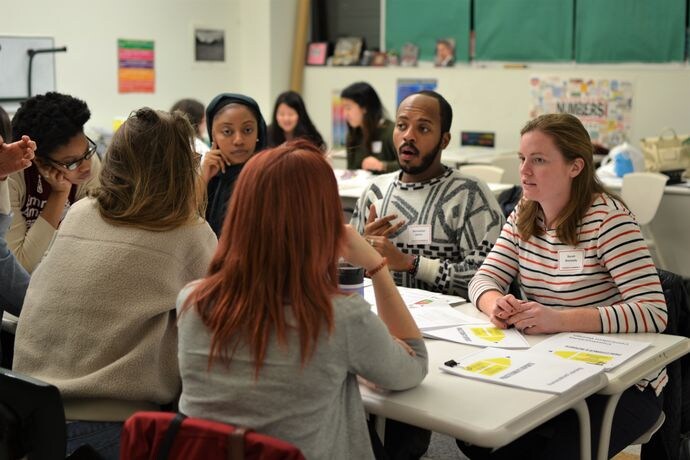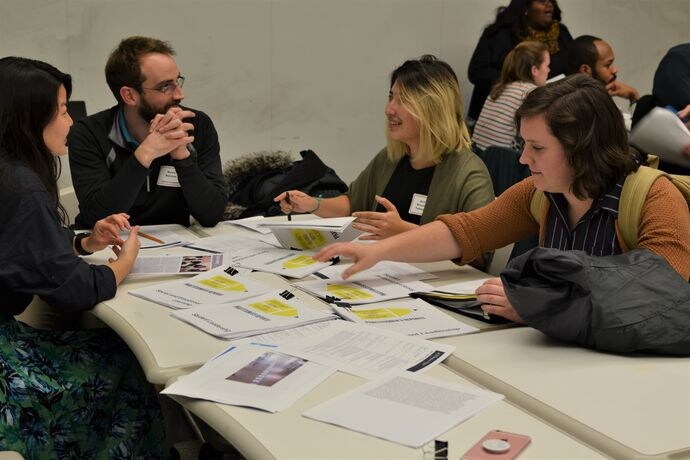A Look Inside Impact Night

January 3, 2019
What are the most effective ways to foster positive peer relationships? How do I bring conversations about race and equity into an elementary aged classroom? How do learner-led activities impact student engagement during class instruction?
These are some of the big questions our 95 second year corps members decided to explore this fall. At the beginning of the semester, each of them chose a specific “Impact Track”: social-emotional learning, personalized learning, Constructivism, and student leadership. Alongside their peers, they formulated learning questions around that particular focus area, hoping to improve student outcomes as they tried new orientations and techniques in their classrooms.
These projects gave our corps members the opportunity to build concrete leadership skills through their role as teachers. And when they came together to share their findings at “Impact Night,” we were blown away by what they had accomplished alongside their students. To get a sense of their findings, below we’re sharing a preview of two corps members’ projects.
Shevontae Harris, Pre-K Teacher at Henry Booth House
Personalized Learning Impact Track
"How can the facilitation of food investigations/experiences increase the percentage of students who eat (and like) fruits and vegetables?"
"I have observed some unhealthy eating habits from my students and hoped to present new eating ideas and foods. One thing that I thought about when completing this project is how food impacts students’ academic success in the classroom. The conversation on healthy foods became a classroom-based conversation with my students. I used read-alouds, props, and visuals to show students various food, ways to eat and prepare them, and how they are produced. Within our monthly parent meeting and memos that are sent home, I communicated to caregivers about the importance of eating certain foods and how to substitute chips, candy, and soda for healthier food options.

I learned that my students actually liked some of the vegetables and fruits that we introduced to them and explored during our monthly Food Experiences, and during lunch. Also, my parents mentioned how they discovered new food likings of their child(ren); since the caregivers didn’t cook and eat many of these vegetables, they hadn’t introduced them to the young child(ren) at home. I believe that’s why many of the children were afraid to eat and try new fruits and vegetables at school. I’m hoping to start my classroom’s own little garden, possibly in the park where we play. I’m also happy to see the increased communication and conversations between caregivers and my center.”
Rachel Weissman-Tsukamoto, Biology Teacher at Dyett Arts High School
Social and Emotional Learning Track
"What is the role of emotional consistency in a trauma-informed approach to education?"
“When asked to imagine a classroom, we tend to imagine somewhere safe and generally uneventful. For some however, that same classroom is full of threats and stressors. A teacher's redirection in a raised voice could signal anger and blame and a new activity could be an unwelcome surprise. These are some of the interpretations I have heard from students, which led me to realize there was a part of my classroom I was not seeing, and definitely not understanding. To address these issues, I began to incorporate the 6 R's into my classroom: Relational (Safe), Relevant (Developmentally appropriate), Repetitive, Rewarding, Rhythmic, and Respectful (to child, family and culture). Research had posited that by incorporating the 6 R’s into a child's day, we stop triggering their stress response system and slowly allow them to feel safe enough to access higher level thinking.

In practice, techniques incorporating Relational and Respectful were mostly used to respond to students in the moment when they were distracted, disruptive, or even in the early moments of a potential altercation. Rather than give detention or send them to the dean, I would have a short check in as I circulated. I would start each class with a quiet, 'How’s it going today? How can I help you be successful in class for the next 48 minutes?' Any disruptive behavior was met with a calm reiteration of expectations and in some cases at my discretion, an option to cool down outside for 2 minutes. Every instance of confrontation about beginning an assignment was addressed with positive encouragement. Through this consistent positivity and calm but firm responses to disruptive behaviors, I began to build positive and affirming relationships with students who had previously been disruptive and disconnected. And while I started this project with particular students in mind, I found that my emotionally consistent and relational approach benefited a majority of my students. The entire class is more understanding and patient, and feeds off of the energy given from a teacher that does not show frustration or agitation when things do not go perfectly according to plan.”


